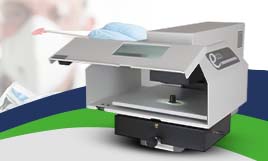NIR Spectroscopy 101: All You Need to Know About
Near Infrared Spectroscopy refers to the analytical technique of using near-infrared radiation for analyzing samples. The analysis of samples is conducted to detect characteristic and compositional traits. NIR has also been utilized for describing near-infrared reflectance.
The ProxiMate is a robust, easy-to-use and compact NIR instrument used popularly for the food and feed industry. It enables reduced downtime in manufacturing and offers rapid quality control of batch samples.
But before we go on to discuss this instrument, let’s take a look at the basics of NIR spectroscopy. Continue to read till the end to learn all about it.
Overview
Near-infrared Spectroscopy is a spectroscopic method that involves use of the near-infrared region of the electromagnetic spectrum. It is based on the combination vibrations and molecular overtone.
One of the greater advantages that NIR offers is that it can penetrate much further into a sample typically than the mid infrared radiation. Hence, near-infrared spectroscopy is not particularly a sensitive technique, however, it can be extremely useful in bulk material probing with minimal or no sample preparation.
Perks of NIR Spectroscopy
The commercial use of NIR spectroscopy started in the 1970s as it became a widespread and popular choice of technique for the analysis of agricultural, food, pharmaceutical and chemical products. With the use of NIR analyzers, users can gain the following benefits -
- Easy to operate - No complicated process to operate them as the normal operations would only require loading a sample cell and turning on the instrument.
- No harmful chemical waste - Since there is no involvement of chemical usage there is no concern for causing chemical wastes that are hazardous.
- Minimal sample preparation - Most of the samples can undergo analysis with particle size reduction or simple grinding method. In other cases, NIR analyzers might not even require any sample preparation.
- Fast and reliable analysis outcomes - Typically, the time required for analysis completion ranges from 10 seconds to 2 minutes. Also, for most analysis instruments the predicted accuracy of results is within 1.5 times of the reference method error with improved precision.
- Simultaneous outcomes for multiple parameters - Multiple constituents can be predicted with one sample analysis.
How Does the NIR Spectroscopy Work?
As mentioned earlier, NIR is a region of the electromagnetic spectrum that comprises unique properties that makes it extremely convenient for characterizing materials. This region typically ranges from 700 to 2500 nm.
This electromagnetic spectrum of area has the choicest combination of attributes for the analysis of liquids, solids and slurry samples. The light in this region interconnects with NH, OH and CH bonds and certain wavelengths are related with each type of bond.
When the NIR light is presented to high chemical compound samples that contain these bonds, the sample absorption of some of the energy occurs in these specific wavelengths and therefore the light reflected has less intensity in these regions.
The differences of the reflected signal (spectrum) can be coordinated with the chemical concentration differences and this results in the formation of NIR calibration basis.
To know more about NIR spectroscopy instruments such as ProxiMate, make sure to get in touch with the best suppliers now.








